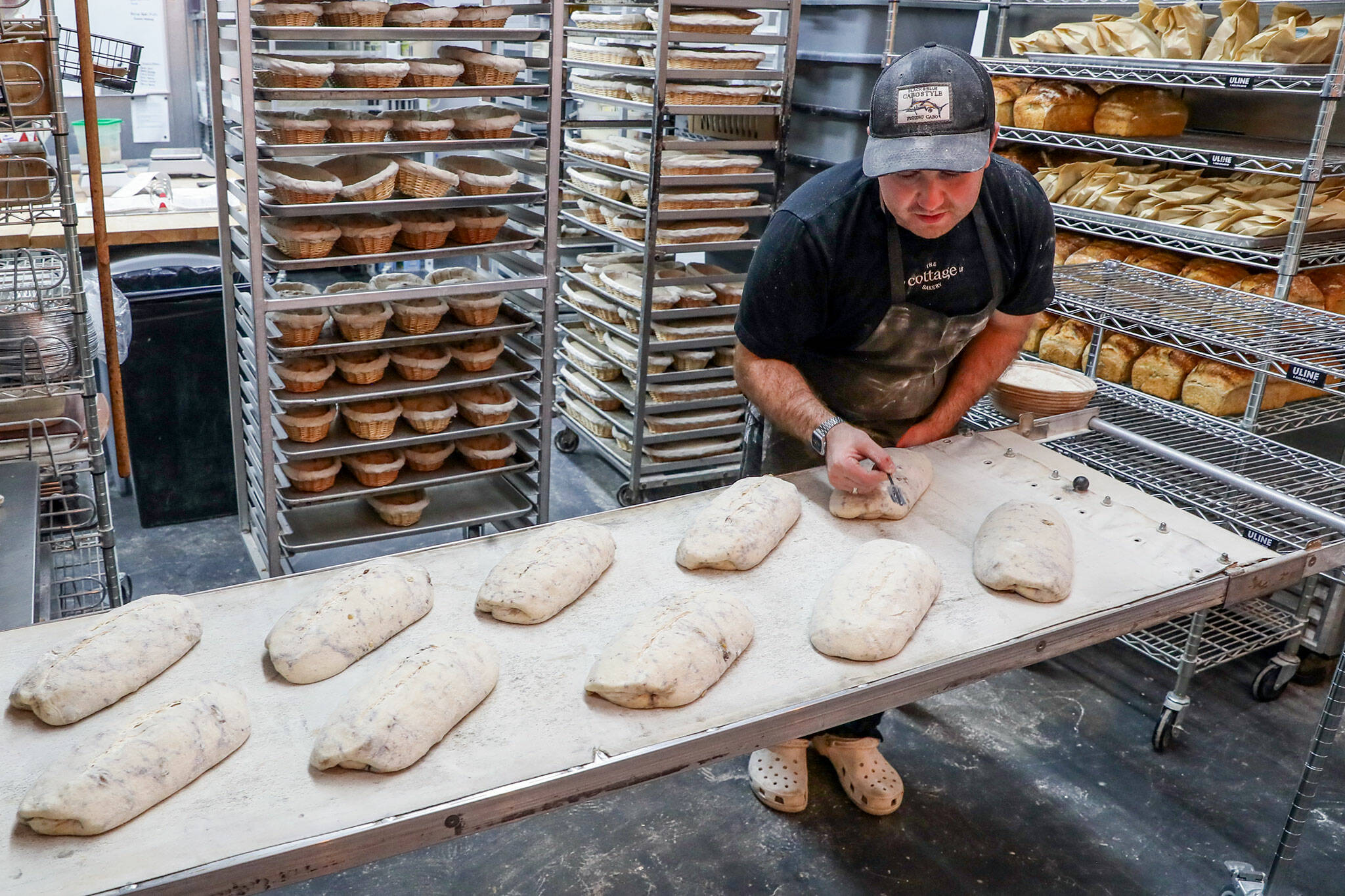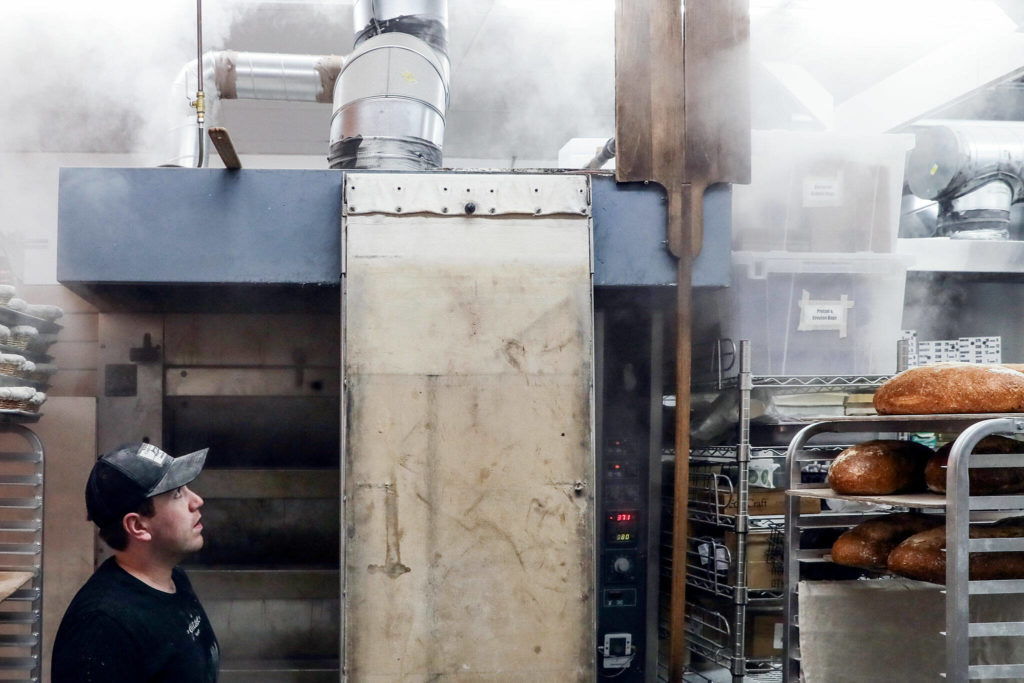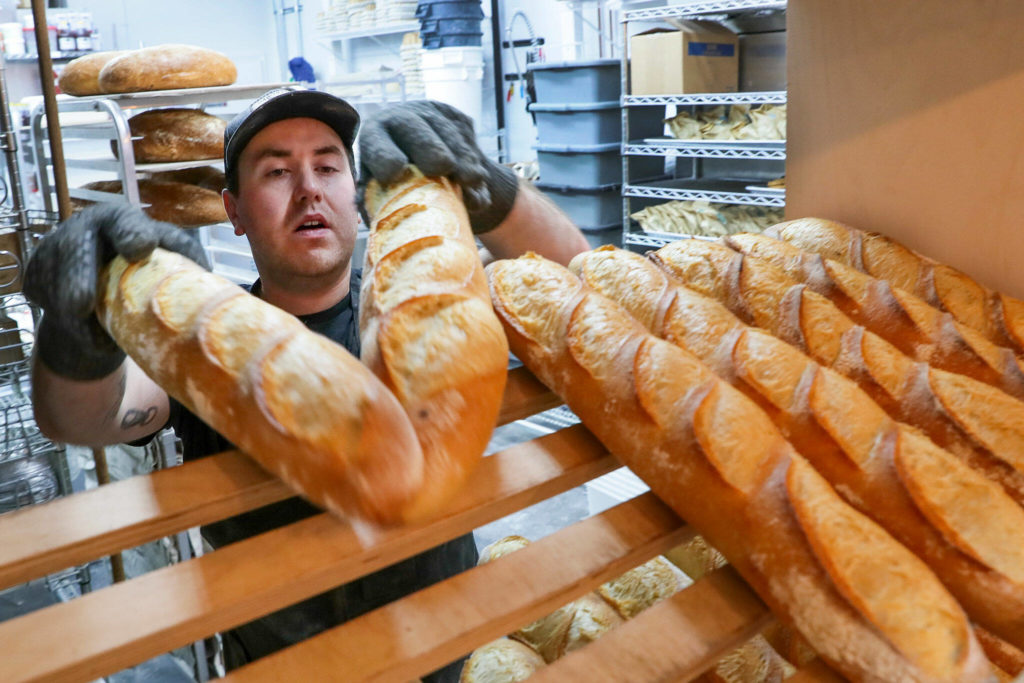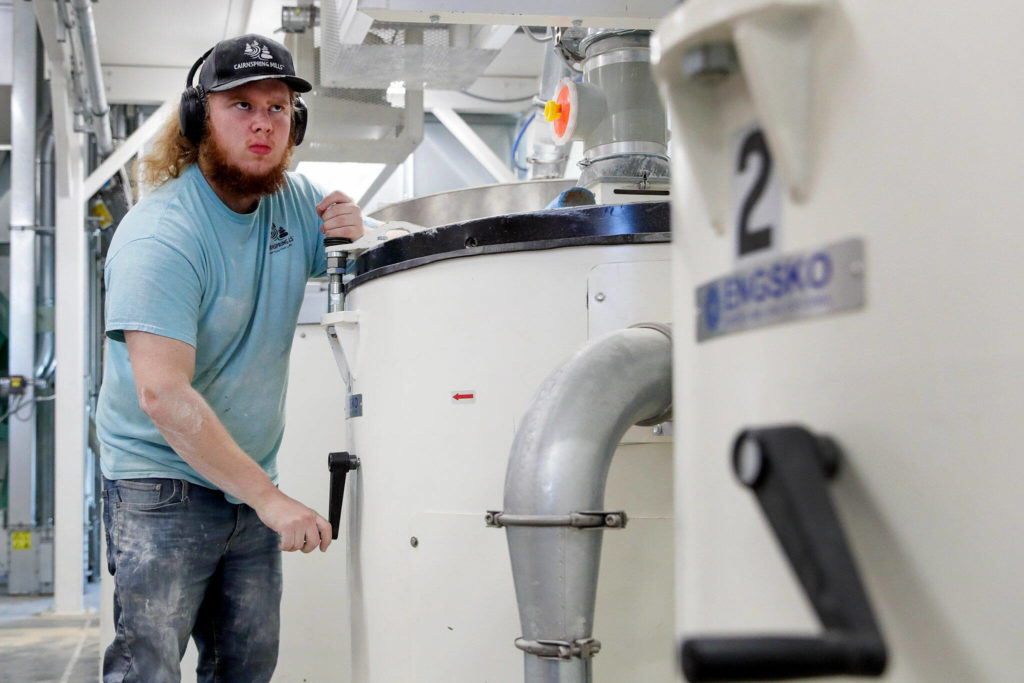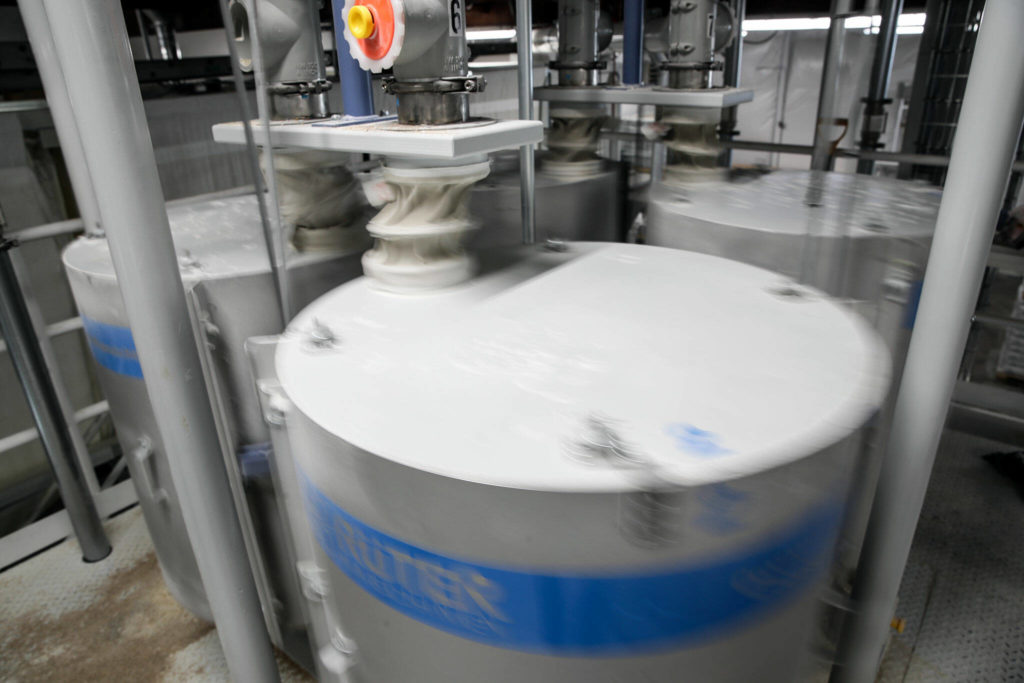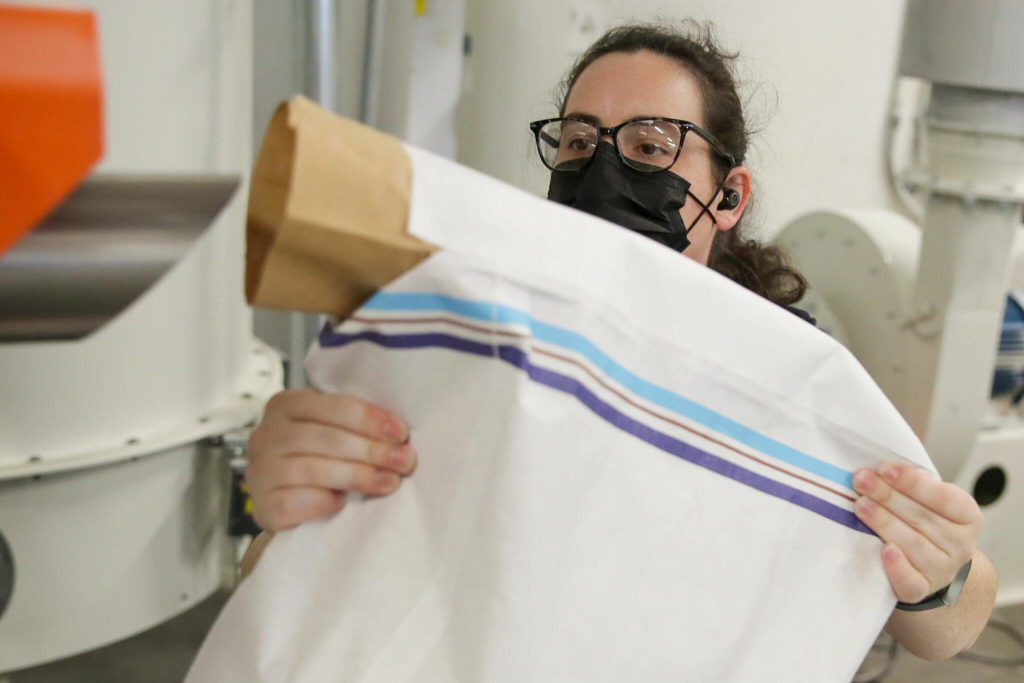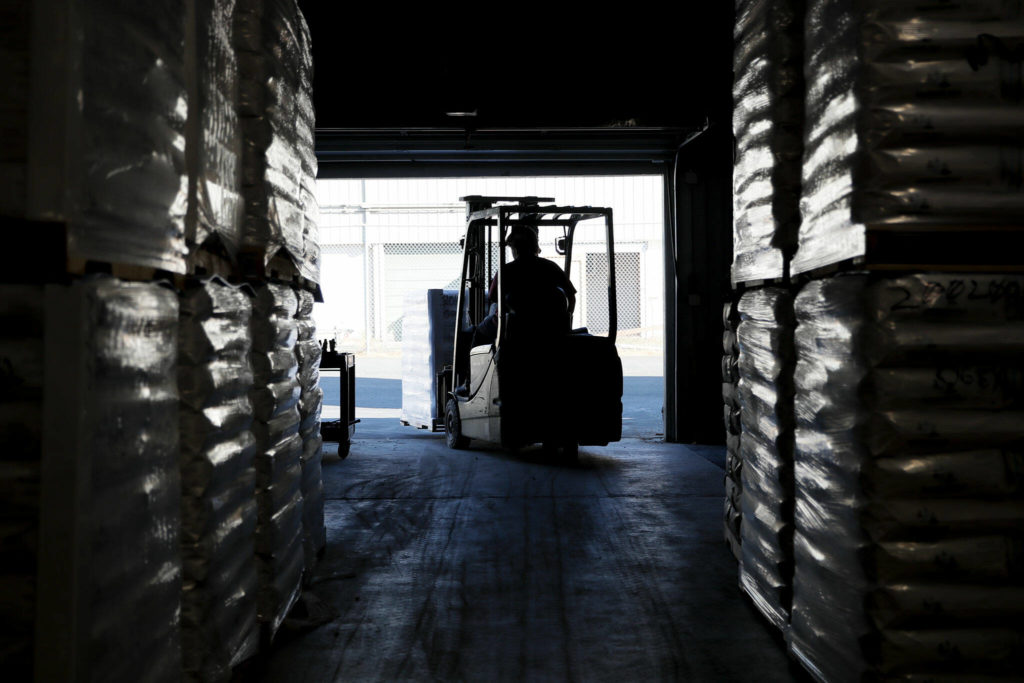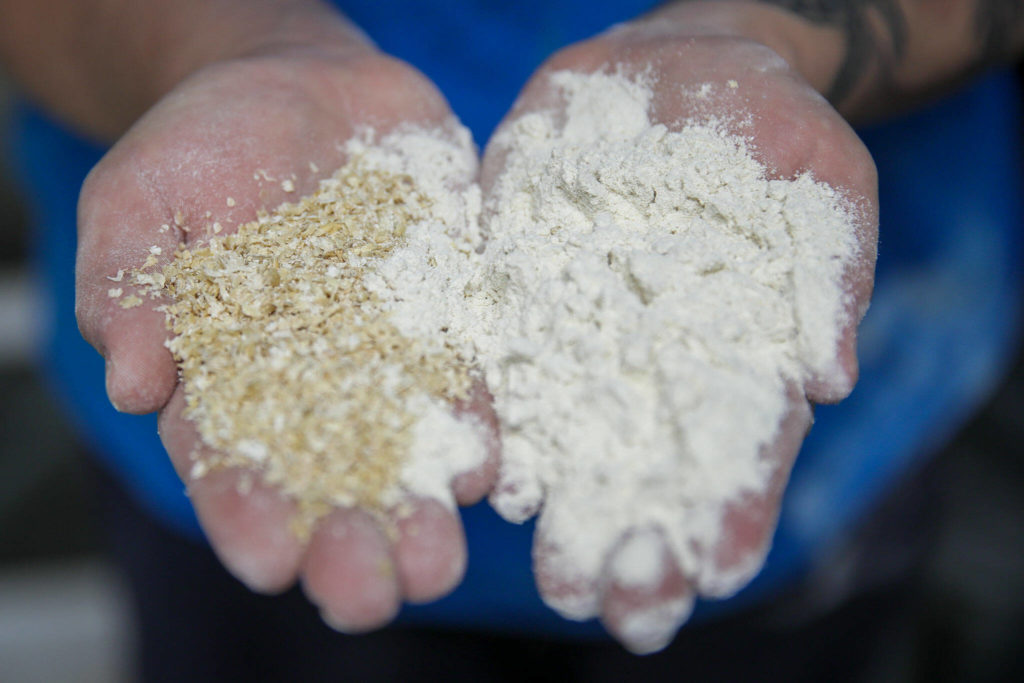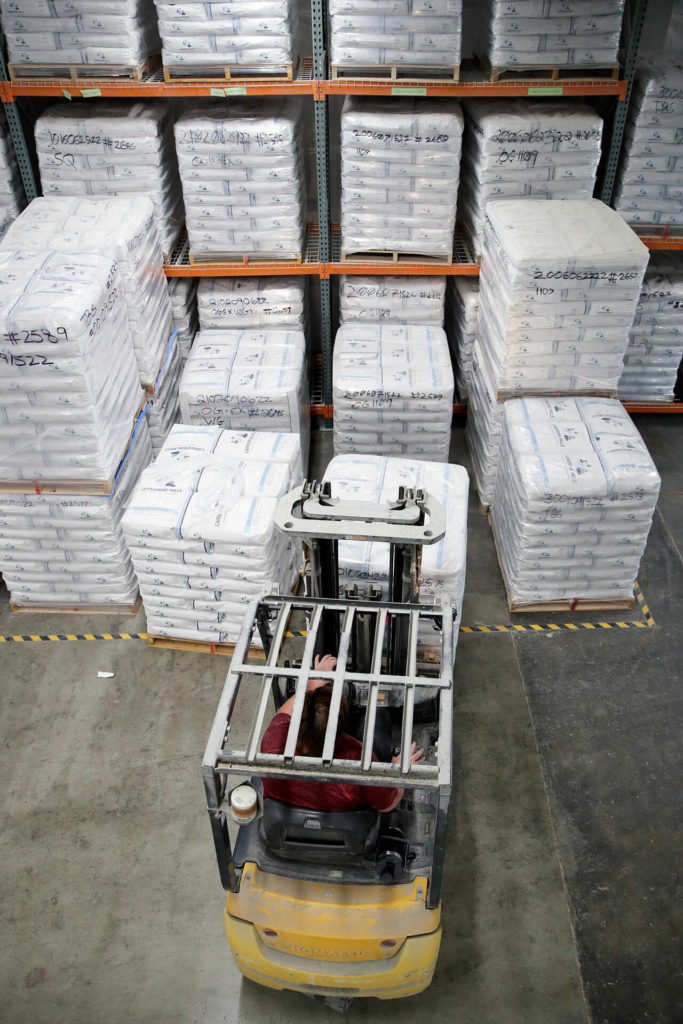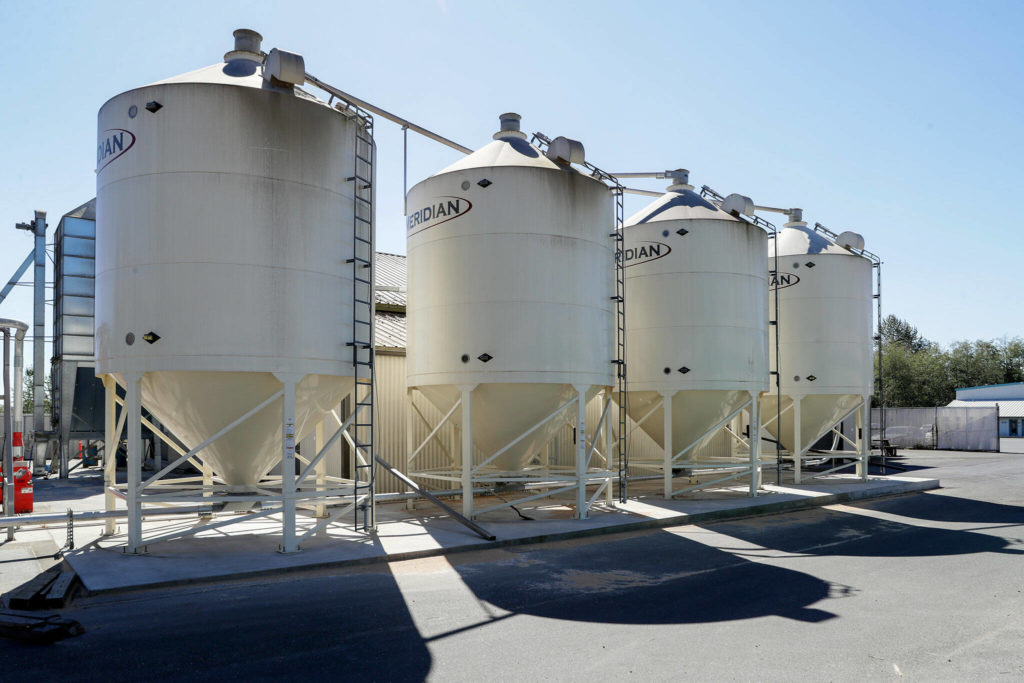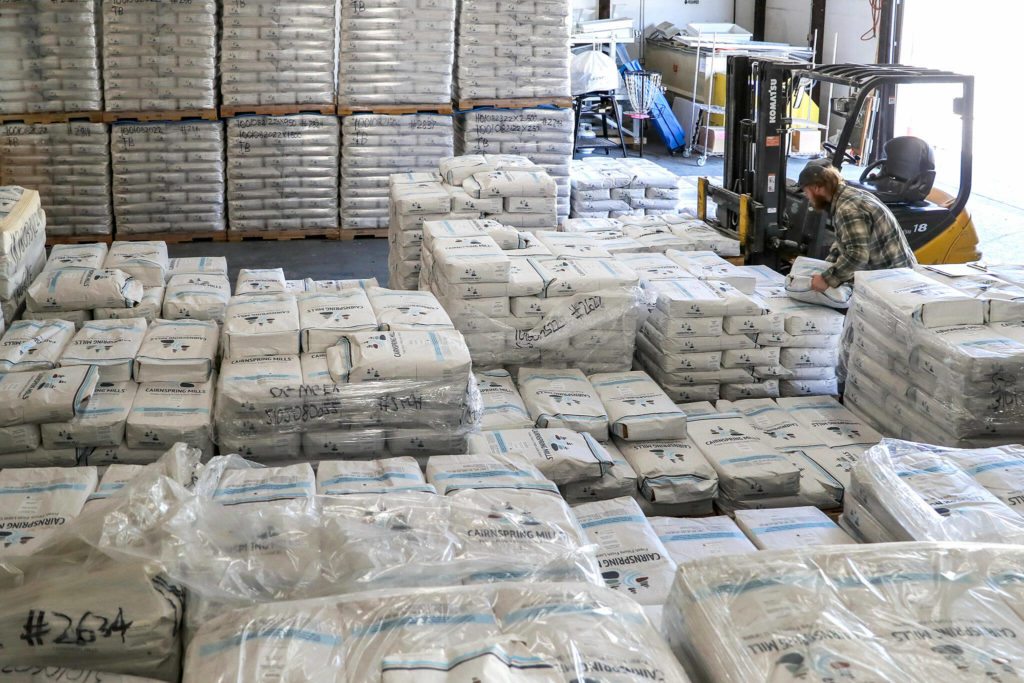EDMONDS — In the earliest hours, Conor O’Neill rouses his sourdough starter with its favorite food, mixing fresh bread flour into the wet, yeasty mass. As it feeds on the stone-milled grain, the starter inhales and bubbles. This is the bread’s beating heart, ready to make hundreds of loaves.
O’Neill is the owner and sole breadmaker at The Cottage, Community Bakery in Edmonds.
He has less than eight hours to bake 350 loaves before opening his doors. On a Friday in September, he switched on the lights at 2:30 a.m., a bit later than his standard self-inflicted call time.
The oven, a fussy Winkler Columbus built in 1990 that O’Neill got practically for free, has been preheating for the past few hours and now hovers between 400 and 450 degrees.
O’Neill has burned himself many times there: “It wakes you up,” he said as he slapped 12 pre-shaped dough balls onto an oven loader. He wore white Crocs, a baseball cap and a Cottage T-shirt underneath a black apron that was quickly and inescapably dusted in flour.
By now, the naturally leavened doughs have puffed up like water balloons, supple and ready for the hot oven. He scores each pale loaf, a simple cut to control where the bread will open: “There’s so much life inside the bread, it needs to go somewhere,” he said, quickly curving the razor over another.
He pushes the loader into the oven, and with a blast of hot steam, the bread embarks on its final journey.
Between rotations, O’Neill sweeps up loose flour and mentally goes through his checklist for the day.
“My starters are moving, I have bread in the oven that I’m about to pull out,” he said. “I have a ticking timer in my head.”
Within minutes, the bread creates a warm, invisible filter over the entire bakery, bringing forth aromas of toasted nuts and popcorn and yeast, something golden, familiar and nostalgic.
O’Neill can smell when the bread is ready to pull. One by one he takes the loaves out — this first round is The Cottage’s traditional country sourdough — inspecting each before loading them on a rack to cool.
Twelve loaves down. Three hundred and thirty-eight to go. (During market and holiday seasons, The Cottage doubles production.)
In the baker’s front area, below a blue-lit sign reading, “EAT REAL BREAD,” six dozen 50-pound flour bags are stacked above the floor, each one labeled “Cairnspring Mills.”
‘One of the last food categories to go local’
Fifty miles north of The Cottage, a nondescript warehouse in Burlington is growing a craft flour revolution.
“When you go to the farmers market, does it matter to you where your food comes from?” Kevin Morse asks customers visiting Cairnspring Mills.
The stone milling company, which Morse opened in 2017, grinds distinctive, Washington-grown grains into flavorful, nutrient-dense flours that bakeries like The Cottage use almost exclusively.
Morse’s visitors exclaim, “Yes!” and rattle off the names of local farms where they buy their organic tomatoes and peaches.
Morse counters: “Well, do you ever go to the grocery store and wonder where your grains come from?”
“No,” most of them admit, after a pause. “I never thought about it.”
“People care where their food comes from, but why don’t they care about flour?” Morse said, sitting in his office on the mill’s second floor. “It’s still 25% of the caloric intake for the average American. It’s a huge part of our diet.”
Cairnspring Mills is surrounded by Skagit Valley farmland amid a backdrop of Mount Baker. Every day Morse drives to his mill, he sees swaths of forested wetlands he helped to permanently protect as The Nature Conservancy’s former lands program director.
When he turned 50, Morse left that job to go into the flour business. People thought he was crazy. They tried to reason with him, saying things like, “It’s a ubiquitous commodity product with no profit margin and no differentiating qualities.”
“And that’s true for the flour of today,” Morse said, referring to mass-produced flour labeled “enriched” and “bleached.”
The grain used to make that type of flour is stripped of its bran and germ — where the flavor, oils and nutrients lie — to produce a more shelf-stable product, with vitamins and other nutrients added back in.
“Flour has been kind of dumbed down over the past 100 years,” Morse said. “It’s this weird thing that’s been made out of sight and mind, for generations. It is really one of the last food categories to go local.”
‘A race to the bottom’
One-hundred fifty years ago, more than 20,000 grain mills existed in the United States. Each mill was an integral part of the surrounding community and economy, and where local farmers brought their grain to do commerce.
Today, the industry is dominated by a small number of conglomerates making up the majority of flour production in the country. Huge milling companies now buy from large-scale farms that plant thousands of acres of grain — usually the cheapest varietal possible. Under the commodity system, which is controlled by global market prices, farmers buy federal crop insurance to make up for declines in grain yields and lost revenue.
“We’re subsidizing the grain and suffering the consequences of those farming practices, including water quality degradation,” Morse said. “Nobody’s taking into account those costs. But they’re real.”
Small-scale milling companies like Cairnspring, however, are succeeding off an entirely different business model, one that pays growers a premium above commodity prices for producing high-quality grain and committing to soil health and regenerative agricultural practices.
This commitment to building a sustainable agricultural model is part of a national flour movement that includes companies as nearby as Fairhaven Mill, also in Burlington, and as far east as Maine Grains.
“All the things I was trying to fix were mostly driven by the industrial food system that our farmers were caught up in, which put them in a race to the bottom,” Morse said. “Nobody talks about it, but our farmers have a higher suicide rate than our veterans. It’s a crisis.”
‘Lean and mean’
Dave Hedlin’s horses neighed outside his wood-paneled office in La Conner. It was late September, an unseasonably sunny and warm prelude to fall. A few weeks ago, Hedlin finished harvesting 30 acres of rye for Cairnspring Mills.
“There’s a lot of enthusiasm for the flour we produce,” the third-generation farmer said. For Hedlin, there are fewer things better than eating local. His Skagit Valley summer ritual involves Hedlin Farm-grown heirloom tomatoes and homemade mayonnaise slathered on a slice of bread, made from his own grains.
“Just about as good as it gets,” Hedlin said.
Hedlin Farms grows a large mix of crops on several hundred acres within a valley that he and other residents like to call the “Magic Skagit.” That includes several varieties of grain, which Hedlin sells to distillers, brewers and milling companies like Cairnspring.
Cairnspring Mills works with Washington growers who engage in organic and other regenerative farming practices, like planting cover crops. The mill measures for qualities beyond yield or protein, testing wheat varieties for flavor, color, disease resistance and suitability to regional soils.
The milling company’s grains are transported less than 200 miles on average. Its supply chain includes three farmers in Eastern Washington, one along the Oregon border and 11 in Skagit County.
Hedlin said he and other Skagit Valley farmers learned long ago to differentiate themselves in the marketplace by focusing on quality crops. For Hedlin, that meant selling specific, high-quality grains to Cairnspring Mills for a premium.
“Years ago, I was getting beat up by a produce buyer,” Hedlin said, as flies buzzed around his wide-brimmed hat in the farm’s main office. The buyer told him, “Dave, you’ve got to be lean and mean. You’ve got to keep your labor costs low. You’ve got to cut your fertilizer costs and your land rent. You’ve got to be the low-cost producer.”
Hedlin listened to the buyer for a few minutes, mulling over his words.
“Yeah,” he responded, “but if I win a race to the bottom, where am I?”
“That’s the question we all need to ask, I think as a society as well,” Hedlin said. “Because that faster, cheaper business model is going to only put us on the bottom.”
‘It takes all of us’
Cairnspring’s milling process begins in 60-ton silos. Workers unload wheat from trucks using a special trailer called a grain hopper. In just 20 minutes, Cairnspring can transport 30 tons of grain pneumatically, sucking up the light yellow crop into the silos.
After drying in the silos for 12 to 24 hours, the grain is pre-ground in a roller mill, which was designed to crush, rip and tear — “like T-Rex,” Morse said. Next, stone mills pulverize the whole grain flour to its familiar powdery finish. Some of the bran, though not all, is sifted off in the process.
Cairnspring Mills is both high-tech and old world. Despite modern equipment like a variable frequency drive, workers still put their ears against the stone mill, listening and feeling for a consistent grind. They still set the stones by hand.
After the flour rolls through a metal detector and meets all food safety requirements, it’s bagged and out the door within three weeks. Cairnspring Mills produces up to 6 million pounds of flour in one year, compared to larger companies like Ardent Mills and North Dakota Mill, each capable of processing millions of pounds in just one day.
Because more nutrients are kept in the grain, the shelf life for Cairnspring’s flour is shorter than its enriched counterparts. Morse’s advice: Use their flour within 10 months — while it’s fresh, just like you would a head of lettuce. Or store it in your freezer.
The Burlington milling company produces several types of flour: Their popular Trailblazer Bread variety uses an aromatic grain called Yecora Rojo. The earthy and rustic Organic Bread Flour is made from their expresso varietal. They also make three types of all-purpose flour: two organic, one responsible conventional.
The Cottage uses their whole grain Gazelle Rye for the bakery’s Dad’s Deli and Seeded Danish ryes.
“If we don’t have a baker, taking enough flour, making it into a beautiful piece of bread and having a customer come by, the circle is not complete,” Morse said. “It takes all of us to rebuild this system.”
‘Don’t lose touch’
Thirty minutes into her shift, The Cottage’s head mixer Sabrina Herrera had two doughs going: an olive oil-enriched challah and buttery brioche. While the challah sputtered away, Herrera threw one-pound blocks of butter into the brioche dough. At first it angrily slapped the butter against the sides of the bowl but eventually gave way and absorbed the fat, making for an exceptionally light and fluffy loaf. As the gluten activated, the pale yellow dough stretched like stracciatella cheese.
Herrera moved on, eventually, to other breads, shoveling portions out with her arms, weighing and loading them into containers for bulk fermentation. She folded herbs and green olives into some sourdough layers, walnut halves and pieces between others. By the end of it, the containers towered over her.
By 8 a.m., an intoxicating mix of coffee, chocolate, buttery buns, lemon and cardamom engulfed the bakery, a sweet switch from the heartier sourdough loaves of early morning.
Like a surgical team over an operating table, The Cottage production team surrounded the stainless steel bench in the final hours before opening, braiding challah loaves, dipping pretzel twists into a lye bath, slicing chocolate chunk brownies, spraying loaf pans. As the crew filled tall rack after rack with rising dough balls and just-baked goods, the bakery became a fast-moving game of Tetris. In the midst of preparations, a burnt smell spread across the table: Three trays of biscotti had overcooked because someone forgot to put a timer on it.
“You’d get ripped at another bakery for burning an oven full of biscotti,” O’Neill said. “I’d rather think about what system we can put in place to avoid that error again. If mistakes aren’t happening, we aren’t pushing the limits we should be.”
O’Neill started The Cottage by accident, in his parents’ Edmonds garage three years ago. He knew he wanted to start a business, and that he loved to bake: He’d even worked at Seattle’s Columbia City Bakery for just over a year. When the pandemic hit in early 2020, O’Neill practiced baking bread loaves and sweets often. One day, he made too much for his family, so he wheeled the extras on a cart down to the bottom of his parents’ driveway.
He posted a photo of the cart on Instagram and wrote, “Take what you want and pay what you’d like.” Neighbors swarmed the cart like an ant colony. O’Neill didn’t know what it was all worth at the time, but the bread was gone by day’s end.
The Cottage, named after his family’s home, eventually took over a shop that used to house American Printing, another iconic — and by today’s standards — old world profession. O’Neill has used Cairnspring Mills flour since his driveway cart.
The Cottage is always plotting for tomorrow’s bread. Balls of dough are always proofing, new shipments of Cairnspring Mills flour are always arriving. And the sourdough always rises (even when a worker mistakes it for trash and throws the starter away, a true end-of-the-world moment for O’Neill).
O’Neill and others in the craft flour industry know that cheap flour — just like other cheap, accessible products — is there for a reason. And he’ll readily have a slice of Wonder bread or Texas Toast.
“But you can also have this artisan, handmade, slow-fermented loaf of sourdough and enjoy that,” O’Neill said.
The Cottage’s traditional country sourdough took three days to make. It’s not the most efficient bread, nor is it widely available. But there are hands on every loaf at the Edmonds Bakery, and ears pressed against the stone mills just 50 miles north. And near Cairnspring, Dave Hedlin walks past his rows of grain, bending down to feel the soil and all that it bears for the farmer, the miller and the baker.
“There is a strong connection to the food we’re eating and the people who make it,” O’Neill said. “And it’s important we don’t lose touch.”
Cairnspring Mills
Contact: 360-488-2921
Website and online orders: cairnspring.com
Find Cairnspring Mills flour: cairnspring.com/pages/store-locator
The Cottage, Community Bakery
7530 Olympic View Drive, Suite 101, Edmonds
Contact: 206-910-9423
Website: cottagecommunitybakery.com
Talk to us
> Give us your news tips.
> Send us a letter to the editor.
> More Herald contact information.
